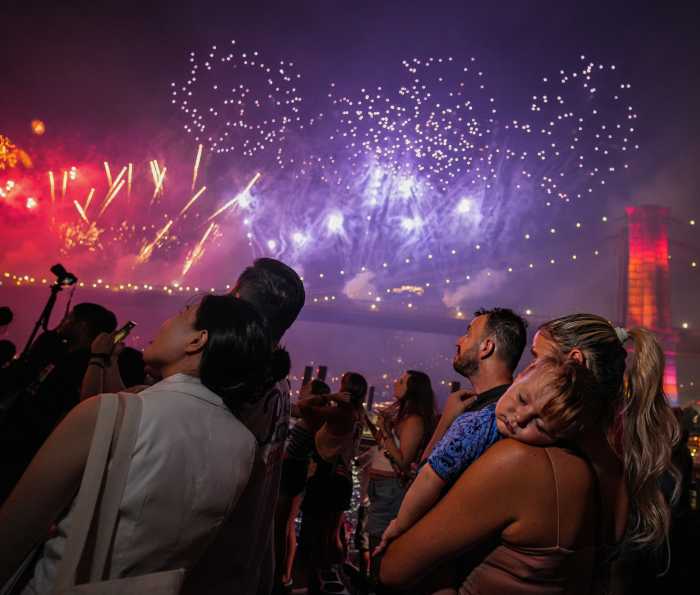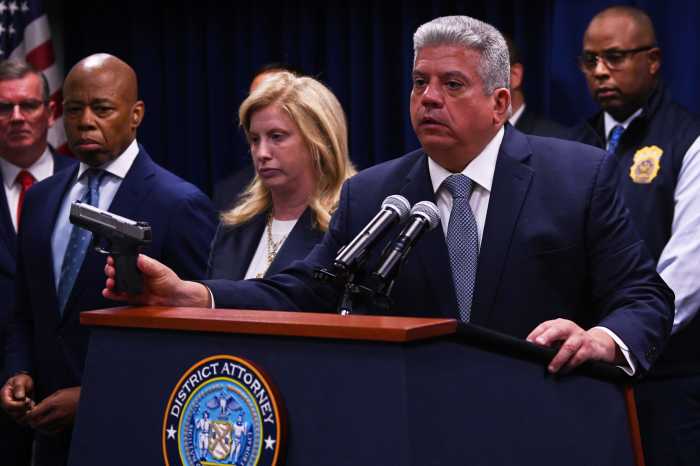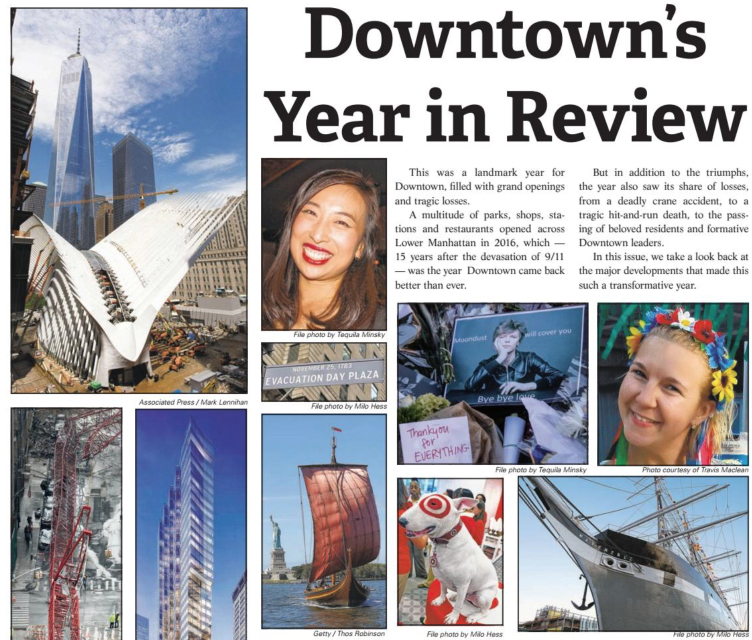
This was a landmark year for Downtown, filled with grand openings and tragic losses.
A multitude of parks, shops, stations and restaurants opened across Lower Manhattan in 2016, which — 15 years after the devasation of 9/11 — was the year Downtown came back better than ever. But in addition to the triumphs, the year also saw its share of losses, from a deadly crane accident, to a tragic hit-and-run death, to the passing of beloved residents and formative Downtown leaders. In this issue, we take a look back at the major developments that made this such a transformative year.
Fidi neighbors
Residents of the city’s fastest growing neighborhood banded together in January to create the Financial District Neighborhood Association, which has since dedicated itself to tackling some of the less charming aspects of Downtown living.
Fidi’s population has doubled since the new millennium, and last year saw a massive surge in residential growth, with roughly 5,300 new locals moving in, according to a study by Community Board 1. And with an estimated 44 new Downtown residential developments bringing as many as 6,537 additional units to the neighborhood by 2018, that boom will only continue.
But Fidi’s shift from a commercial to a residential area brings with it quality of life woes that are unique to Manhattan’s oldest neighborhood, including gridlock, endless construction, and legendary garbage piles as tall as a man and as long as a city block.
The neighborhood association, which hosted its first meeting in February, has grown to about 200 members and continues to pick up steam as the group pursues solutions for the major issues plaguing locals, by means such as lobbying local legislators to consider new regulations to curb the massive garbage piles, and pushing a petition on Transportation Alternatives calling on the city to fund a comprehensive traffic study of Lower Manhattan.
Bye bye, Bowie
Downtown lost several prominent figures in 2016, starting with David Bowie in January. Fans flocked to Soho when the news broke and turned Bowie’s Lafayette St. home into an impromptu shrine, healing the sidewalk with flowers, candles, photos, and heartfelt notes.
Bowie was a devoted denizen of Downtown since 1999, and headlined the May 2002 concert in Battery Park City that was part of the inaugural Tribeca Film Festival aimed at drawing people back to Lower Manhattan in the wake of the 9/11 attacks.
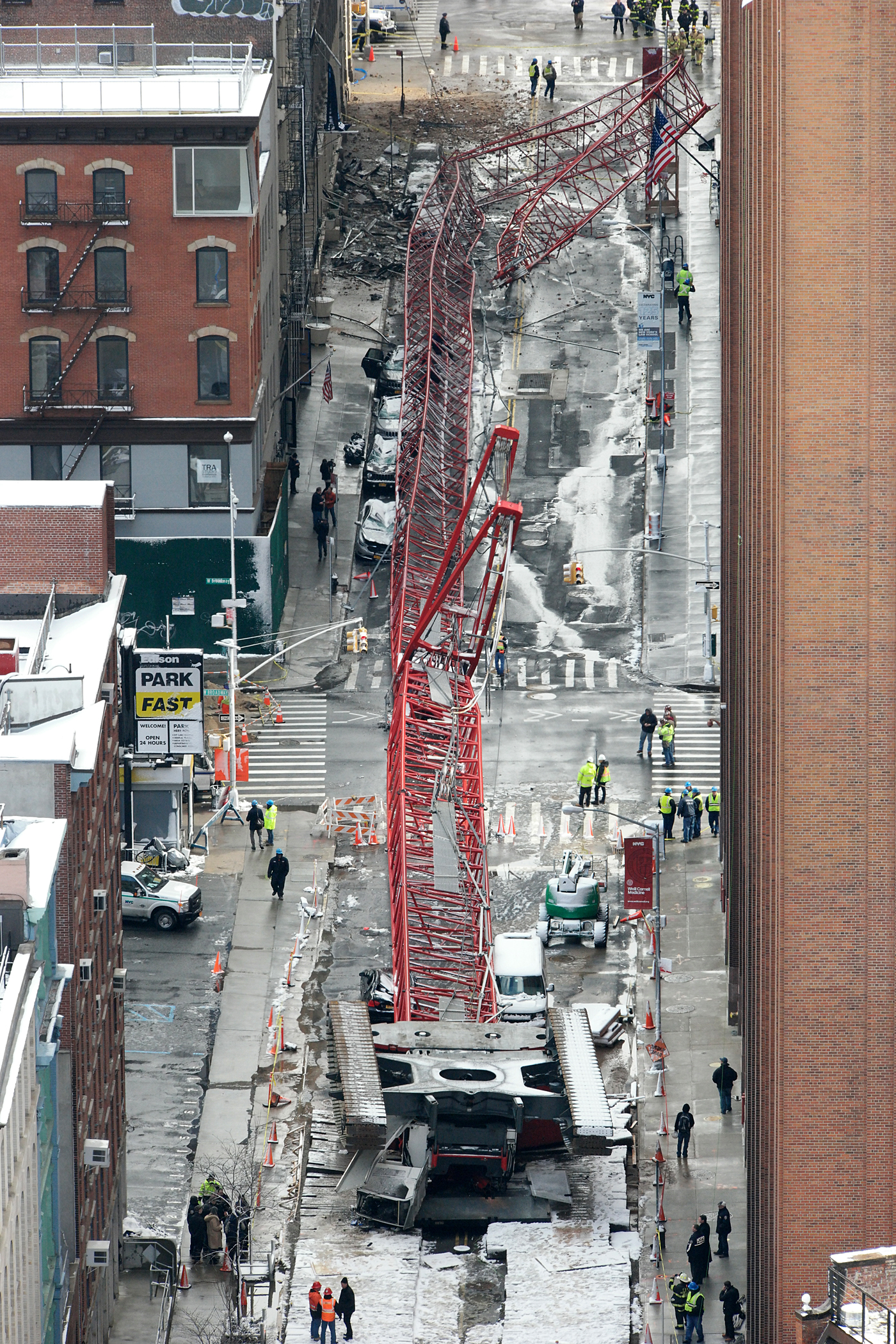
The 565-foot crane crashed down along two blocks of Worth St. between Hudson and Church Sts. in February.
Crane crash
A crane collapsed on Worth St. in Tribeca in February, killing one man and injuring three other people — and led to a laundry list of reforms that have yet to be fully implemented.
The 565-foot crane toppled down along Worth St. just before 8:30 a.m. on Feb. 5, leaving a two-block stretch of devastation between Hudson and Church Sts., crushing dozens of cars, damaging four buildings, injuring three people, and crushing 38-year-old mathematician David Wichs.
A federal investigation by the U.S. Department of Labor’s Occupational Safety and Health Administration cast blame on contractor Galasso Trucking and Rigging in September, slapping it with $22,448 in fines for operating the crawler crane in high winds that exceeded the machine’s specifications.
On the city’s end, an investigation by the Department of Buildings decided earlier this month that fault lay with crane operator Kevin Reilly, suspending his license and pushing for the Office of Administrative Trials and Hearings to revoke it permanently.
Meanwhile, the DOB is currently implementing the 23 recommendations made by a working group formed by Mayor de Blasio in June aiming to prevent similar accidents in the future.
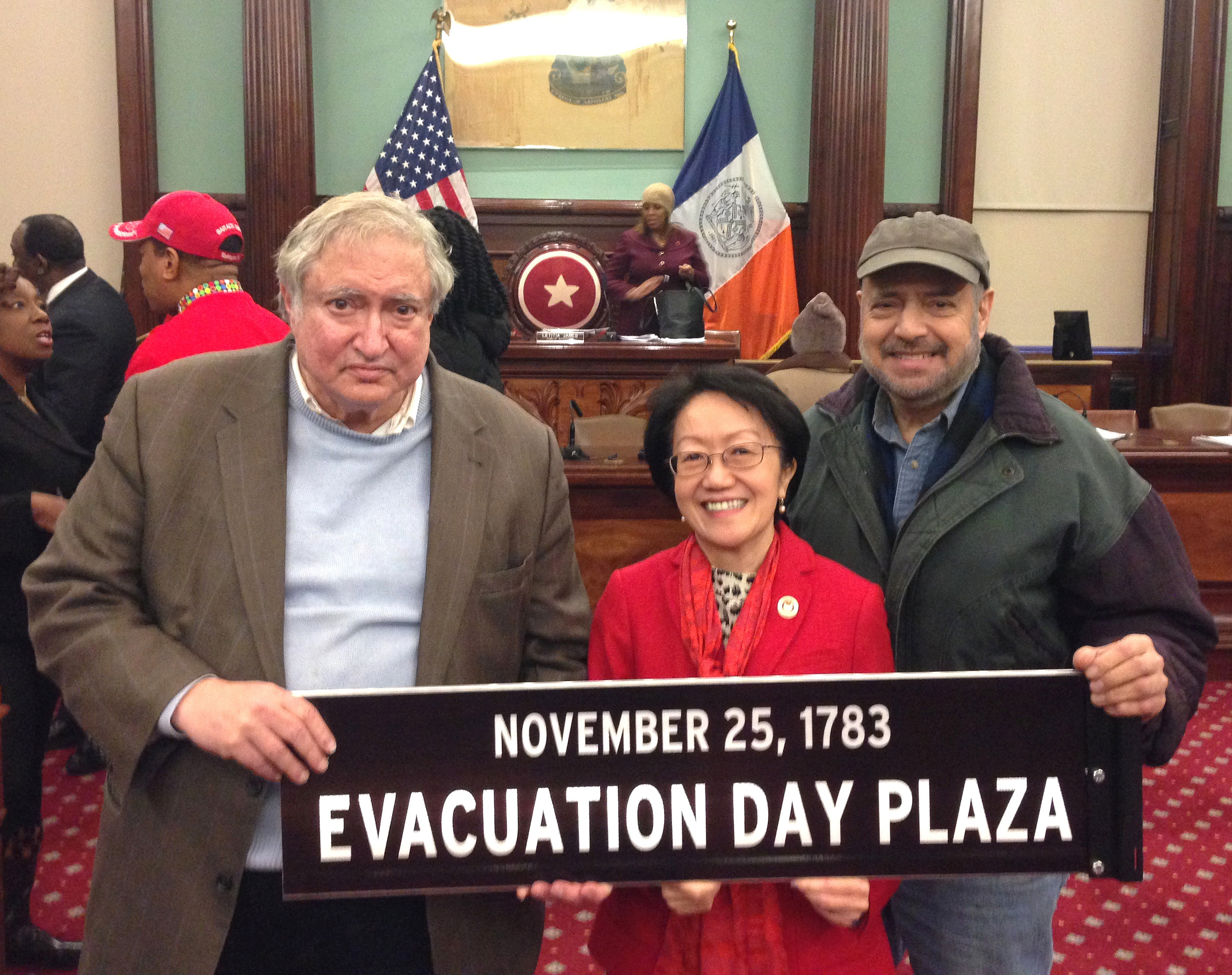
Downtown’s Councilmember Margaret Chin, center, beams in the Council chamber as she holds up the “Evacuation Day Plaza” sign just approved for Bowling Green, flanked by Lower Manhattan Historical Society co-founder James Kaplan on the left, and Bowling Green Association head Arthur Piccolo on the right.
Evacuation Day Plaza
Downtown history buffs won a contentious battle in February to co-name Bowling Green as Evacuation Day Plaza to commemorate the momentous day in 1783 when the British finally ended the occupation of Lower Manhattan after the Revolutionary War. On Nov. 25 that year, the fleeing Brits had nailed the Union Jack to the top of the flagpole at Bowling Green and then greased the pole, but a patriotic former prisoner of war named John Van Arsdale managed to climb the flagpole and replace it with the Stars and Stripes just before George Washington’s triumphant return to Downtown.
The Lower Manhattan Historical Society recently revived the long-dormant tradition of marking Evacuation Day, which was avidly celebrated in New York until about 100 years ago, and pressed the City Council to co-name Bowling Green in its honor. But Council staffers initially refused to put Evacuation Day Plaza on the list of co-namings to be approved earlier this year, but in the face of local outrage, they relented.
Chopper deal
The city worked out a deal with helicopter tourism operators in February that slashed by half the number of flights out of Downtown’s Pier 6, but guaranteed the industry’s survival, miffing residents and elected officials who sought to outlaw the choppers entirely.
The deal, which was formalized over the summer in a new concession agreement and is expected to ground roughly 30,000 flights, was hammered out by the Economic Development Corporation in an effort to appease locals living around the Downtown Manhattan Heliport, who were subjected to some 59,000 flights in 2015.
But the deal came as a disappointment to Downtowners such as 22-year Battery Park City resident John Dellaportas, who had hoped local lawmakers would kill the industry outright.
“It’s a complete sellout by our elected officials,” Dellaportas said. “They promised us they were going to try to enact a complete ban, and instead behind our backs cut a deal with the helicopter industry.”
Community Board 1 chimed in shortly after the deal was announced, passing a resolution that called on the city to cut off the industry after the new concession agreement runs out in 2018.
Those Council members who had crusaded against the industry hailed the arrangement as a victory, while pledging to continue the fight to eliminate the heli-tourism industry eventually.
“We have long called for a complete ban on nonessential tourist helicopters from the Downtown Manhattan Heliport, and still support a full ban,” proclaimed a joint statement by pols including state Sen. Daniel Squadron, Congressman Jerrold Nadler, Congresswoman Nydia Velázquez, Borough President Gale Brewer, and Assemblywoman Deborah Glick.
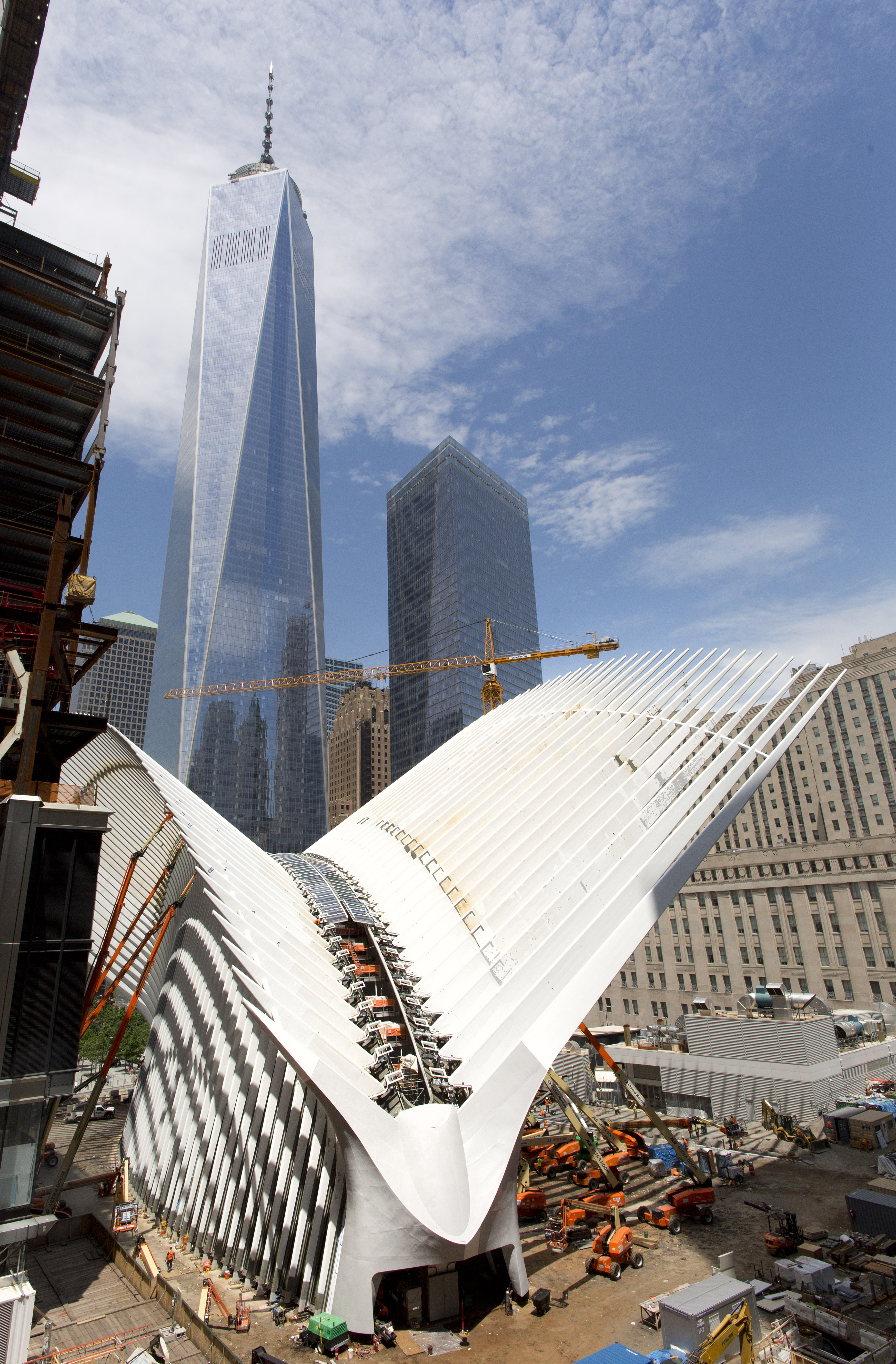
The Oculus transit hub, designed by Santiago Calatrava, has been under construction for more than a decade — and it was even quite done yet when the iconic atrium opened in March.
Eye opening
The long-awaited, $4-billion Oculus transit hub finally opened this year after more than a decade of construction, but it was a slow-motion process that didn’t finish until December.
It started with the softest of soft openings when the Port Authority welcomed the public into the vast, ribbed atrium designed by Santiago Calatrava in March, to meet its promised debut date, but only through one door, and with a conspicuous absence of fanfare. It was just as well, because the vaunted “transit hub” was only connected to one train line — the PATH.
Nearly three months later, the concourse linking the Oculus to the 11 subway lines that converge at the Fulton Center station was finally opened with a grand back-patting ceremony in late May, but the dozens of retailers slated to fill the complex still weren’t yet ready to open. It wasn’t until August that the Westfield WTC shopping center made its debut, and even then some retailers were struggling with finishing touches on opening day and some storefronts were still empty.
Finally, in late December, the Port Authority opened the concourse linking the E train to the Oculus, incorporating elements from the original pre-9/11 station.
Seaport savior passes
Stanford and his wife Norma created a preservation group called Friends of South Street in 1966, and founded the museum the next year, leading the institution for nearly a decade. It was under his watch that the museum’s last remaining tall ship, the Wavertree, came to the Seaport, and he returned to the Seaport in 2015 to see it off when the historic ship set sail for Staten Island for a $13-million, city-funded restoration.
LMDC pays out Deutsche Bank dough
The Lower Manhattan Development Corporation — a joint city and state agency created to manage reconstruction after 9/11 — paid out $50 million in March to help fund 14 projects around Lower Manhattan with money from a settlement paid by a contractor responsible for the catastrophic fire at the Deutsche Bank building that killed two firefighters almost a decade ago.
Half of that money was split between improvement projects at the East River Esplanade and Hudson River Park. The former received $15 million for paving and other improvements, including new railings and furnishings to open some beach access near the Brooklyn Bridge. Hudson River Park received $10 million to complete work around Pier 26 and make other improvements.
Other recipients included the South Street Seaport Museum, the Flea Theater, the Battery Conservancy, the National 9/11 Memorial and Museum, Manhattan Youth, the Downtown Alliance, and the Downtown Boathouse. The LMDC doled out the funds partially based on public input and the help of a working group of state, city, and local officials.
CB1 Chair steps down
Downtown’s designated band of civic do-gooders, Community Board 1, came under new management this year after former chairwoman Catherine McVay Hughes suddenly announced in April that she woundn’t seek a third term as leader, though she said she intended to remain on the board.
CB1 chairs typically serve for three two-year terms, so her decision came as a surprise to the rest of the board.
Hughes’s impending departure created a power vacuum that led to a short-lived leadership struggle between longtime board members Paul Hovitz and Anthony Notaro, and the pannel braced for the first contested chairmanship race in three consecutive elections.
Hovitz himself declared his intention to run as mostly a desire to provide some sense of a contest, saying, “I think that nobody should really run unopposed — unless they’re John F. Kennedy, or someone like that.”
But those words only served to make it all the more peculiar when Hovitz dropped out of the race in May, and instead announced his candidacy for vice chair of the board with Notaro’s endorsement, essentially joining forces with his former rival.
Both Notaro and Hovitz went on to victory in June, while Tammy Meltzer took over as secretary from Adam Malitz, who remains on the board. Both Joel Kopel and Dennis Gault held on to their offices of treasurer and assistant secretary, respectively.
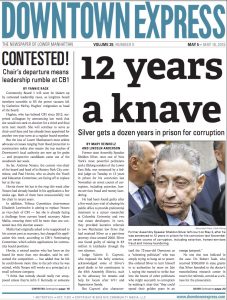 Silver sentenced
Silver sentenced
In May, disgraced former Assembly Speaker Sheldon Silver was sentenced to 12 years in prison for his 2015 conviction on seven counts of corruption, including extortion, honest-services fraud and money laundering. Judge Valerie E. Caproni characterized Silver as a “scheming politician,” and said she imposed the harsh sentence on the 72-year-old Democrat because she wanted to strike fear into the hearts of other politicians by making it clear that “they could spend their golden years in an orange jumpsuit.”
Caproni ordered Silver to turn himself in to authorities by noon on July 1, but his lawyers were able to keep him out of the big house while he appeals his conviction, which legal eagles say he has a good chance of seeing overturned. A unanimous ruling by the U.S. Supreme Court in June overturning the 2014 conviction of former Virginia Gov. Bob McDonnell on similar corruption charges could lead to a new trial for Silver, who remains a free man.
Alliance leader passes
Bernstein joined the Downtown Alliance in 1997 and as chief operating officer and chief financial officer of the group — as well as its acting president on three occasions — he helped guide the BID through some of the most turbulent times in Lower Manhattan’s history, including the aftermath of the 9/11 attacks, the 2008 Financial Crisis and, most recently, the devastation of Hurricane Sandy.
Oval opens
The Oval is just that — an elongated circle of green space for locals and tourists to enjoy at The Battery. It sits at the center of the park at the meeting point of Battery Pl. and State St. Its open space provides plenty of room for sunbathing and its 38 trees offer plenty of shade.
The lawn is pristine Kentucky Blue Grass that the conservancy picked for its hardiness. No noxious chemicals would be needed to keep the Oval green and attractive under the feet of thousands of visitors, the conservancy said, making the Oval decidedly pet- and child-friendly.
The Battery Conservancy held a two-year-long design competition for moveable outdoor chairs specifically for the Oval. Out of 679 designs, the Parks Department and Conservancy chose Canadian designer Andrew Jones’ flower-inspired Fleurt chair.
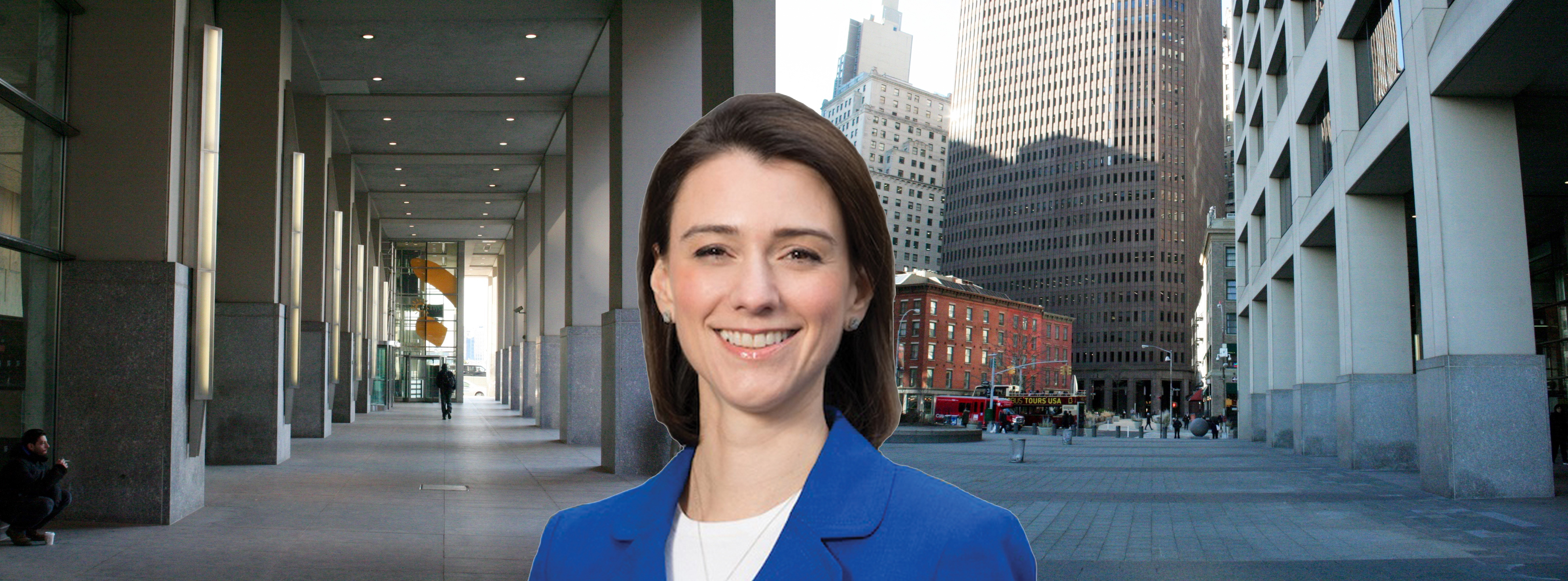
Downtown Alliance president Jessica Lappin (inset) wants to allow developers to put retail space into Water Street’s “uninviting and underutilized” public arcades (left) in exchange for sprucing up the area’s equally bleak public plazas (right), but Community Board 1 had other ideas.
Water St. arcade games
A controversial scheme to hand over two football fields worth of public space along Water St. to landlords for retail use was approved by the City Council, only for Crain’s to report that federal flood regulations may make development there prohibitively expensive.
The covered walkways — also called pedestrian arcades — were concessions made to the city in the 1960s through the 1980s by developers that allowed them to build higher than zoning rules allowed.
The arcades were meant to give pedestrians an alfresco roof in the event of inclement weather, but the Downtown Alliance panned the spaces as unattractive, uninviting, and underutilized, and said that converting the arcades to retail space would make Water St. more inviting.
The plan was condemned by members of Community Board 1 in February, who saw the plan as a gratuitous giveaway to landlords, and complained that a shady push-poll sponsored by the Alliance was trying to concoct a false impression of public support.
Nonetheless, the scheme was duly approved by the City Planning Commission in April, and the City Council gave the plan its seal of approval in June, seemingly putting an end to the whole torrid saga.
But then Crain’s came along and rained on the developer’s parade in October, when the publication reported that developers looking to build out Water St., which is located in a designated flood zone, would be required to erect shops able to withstand 12-feet of sudden sea rise, which would necessitate all manner of expensive safety improvements.

Upper West Side resident Olga Cook was struck and killed in June while biking across Chamber St. along the Hudson River Greenway, which parallels the West Side Highway. Her death has spurred renewed interest in improving safety at the notorious intersection.
Hit-and-run hits a nerve
An alleged hit-and-run accident that claimed the life of Upper West Side bicyclist Olga Cook in Battery Park City in June led to long-overdue safety improvements along West St. in Lower Manhattan.
When 26-year-old Samuel Silva took a right turn onto Chambers Street from a southbound West St. lane, he allegedly collided with Cook as she headed north across Chambers St. along the Hudson River Greenway. Witnesses said he then sped off, only to be found three blocks away by an off-duty MTA police officer.
As Silva’s fate hangs in the balance, the city has already added safety improvements — including new signal phases, additional bollards, and high-visibility crosswalk paint — to the accident-plagued intersection which has seen 17 crashes over the past five years, according to Greg Haas, a city planner for the Department of Transportation.
Similar safety improvements are expected to be installed at West St. intersection south of Chambers Street come Spring 2017.
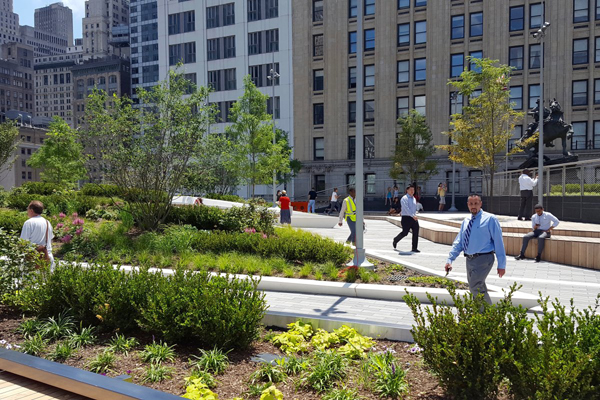
The one-acre elevated park in the heart of Downtown includes 19 planters filled with more than 50 trees, as well as shrubs and perennial flowers, offering visitors an escape from the frenetic bustle of Lower Manhattan life.
Liberty park opens
The $50-million plaza connects to the Liberty St. pedestrian bridge — which reopened the same day — offering an elevated connection over busy West St. to high-end shopping of Brookfield Place in Battery Park City.
A 336-foot-long vertical garden dubbed the “Living Wall” running up the side of the bus garage features 22,000 plants growing out of the northern façade along Liberty St.
Up top, the park includes 19 planters stocked with trees, shrubs, and perennial flowers, along with a sapling grown from the original horse chestnut tree in Amsterdam that inspired Anne Frank as she hid from the Nazis.
The park was hailed as a great success by locals, many of whom were merely happy that the space was put to use as an amenity for locals — not a parking lot, according to then Community Board 1 chairwoman Catherine McVay Hughes.
“It was almost just going to be the top of another garage,” Hughes said. “And with community input, it has become a wonderful green space. We’re very grateful to have this here.”
Proto-punk passes
Legendary punk-rock pioneer Alan Vega died peacefully in his Fidi home at age 78 in July.
The co-founder of the proto-punk act “Suicide,” who once dodged an axe hurled from the audience during a performance in Scotland, mixed elements of what would come to be known as punk and electronic music, and introduced them into the mainstream through eccentric and sometimes violent performances which were billed on the first fliers to declare the new genre “punk music.”
Vega eventually settled into a much quieter life in the Financial District with his wife Elizabeth Lamere and son Dante, whom he would accompany to local little league games — dressed head-to-toe in black, of course.
Eataly opens
The opening of gourmet food market Eataly at 4 World Trade Center in August was the highlight of the year for Downtown Foodies.
The 40,000-square-foot Tuscan food Mecca of restaurants, markets, and food counters created by celebrity chef Mario Batali and his partners was a sorely needed amenity for Downtown residents who had long lamented a lack of culinary options in the fast-growing neighborhood.
Eataly partner Joe Bastianich said that Downtowners have as much to offer the trendy market as Eataly offers them.
“When Nicola Farinetti opened Eataly Flatiron in 2010, it changed the neighborhood and Manhattan,” Bastianich said. “As Eataly opens Downtown, the opposite will happen, and the store will evolve as part of the rejuvenation of this part of the City.”
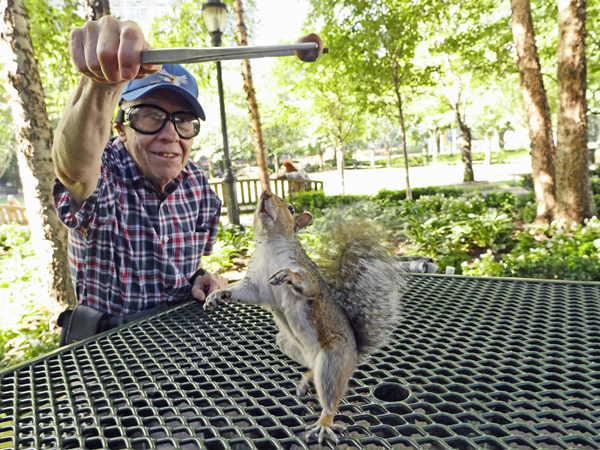
Ira “The Squirrel Man” Rosen has been feeding the fuzzy-tailed denizens of BPC’s Pump House Park for years, but he has seen the local squirrel population plummet over the summer.
Squirreled away
Squirrel populations in the waterfront neighborhood plummeted in 2016, according to locals, who claimed that the bushy-tailed nut hoarders had all but vanished.
Anecdotal accounts of the squirrels’ sudden disappearance abounded, but the closest thing to an official survey of the local rodents came from Ira “The Squirrel Man” Rosen, an elderly Chelsea resident accustomed to feeding squirrels at the neighborhood’ Pump House Park on a near-daily basis. He claimed there were nine squirrels living there at the beginning of the year, but that the population had dwindled to just two by August.
Many theories were floated to explain the sudden squirrel exodus, including that Hurricane Sandy had driven them away and that poisoned mousetraps installed around the Brookfield Shopping Center had all but wiped them out.
The most likely theory, however, came from the chief agriculturist of the The Battery, a nearby greenspace, who said that the newly renovated public park just south of BPC was lousy with squirrels now that years of construction had come to an end, and suggested that the neighborhood’s squirrel population had likely just moved down to the greener pastures.
Regardless, locals lamented the absence of their furry, tree-climbing friends, whose presence, they agreed, was much preferable to their absence.
“Just trees don’t make a park, or grass or flowers,” Rosen said. “Then you’d call Macy’s a park when they do the flower show. For me, a park needs animals. Any place without animals, it’s too quiet, it’s too dead, there’s no life.”
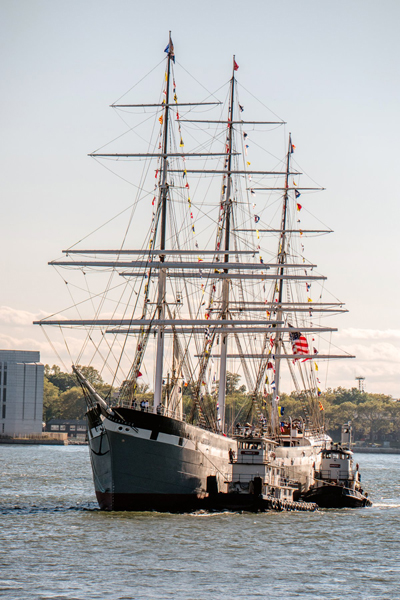
The Wavertree returned to the South Street Seaport Museum’s Street of Ships on Sept. 24 after a $13-million, city-funded restoration in Staten Island.
Peking ducks out, Wavertree returns
The century-old, four-masted barque Peking set sail for Germany in September after 40 years at the Seaport. Its final voyage took it to the maritime museum of Hamburg, the city where it was built in 1911. She was saved from the scrap heap by the South Street Seaport Museum in 1974, but spiralling maintenance costs forced the cash-strapped institution for find the Peking a new home.
But the Seaport didn’t have to go long without a tall ship at the dock, because later that month the museum’s flagship, the Wavertree, returned to the Seaport after a 17-month, $13-million restoration. The 131-year old, wrought-iron ship — the last of its kind in the world — first came to the South Street Seaport Museum in 1968, and was added to the National Register of Historic Places in 1978.
Vikings raid North Cove
Lower Manhattan welcomed a curious band of mostly bearded and unshowered sailors in September when the world’s largest Viking longship, the Draken Harald Hårfagre, landed at North Cove Marina after a five-week trip across the Atlantic and a summer sailing the rivers and lakes of North America.
The three dozen sailors were greeted by a crowd of more than 100 Norsephiles when they pulled into a berth at the marina, many of them Scandinavian-blooded New Yorkers swelling with pride at the accomplishments of their distant cousins.

It may be the world’s largest Viking ship, but the 79-foot mast of the Draken Harald Harfagre still can’t compare to the mast atop One World Trade Center.
“Its just a beautiful ship,” said Lori Bentzen, who came in from Queens. “It’s like our ancestors did years and years ago, and they’re still doing it to honor their history. It’s beautiful.”
The Draken Harald Hårfagre was commissioned by Norwegian energy tycoon Sigurd Aase. Aase tasked his country’s best traditional shipbuilders to construct the ship using old-fashioned tools and methods available to their Viking ancestors. They based the design largely on archaeological sources and Viking literature, making the Draken the closest copy of actual Viking ships that exists today.
Once back on solid ground, the seafarers said they were just happy to get a hot shower, do some laundry, and lay their heads on a real bed — not to mention get in some much needed R&R in the world’s greatest city.

Bullseye, Target’s face-painted bull terrier mascot was on his best behavior as he greeted shoppers when the Tribeca location opened in October..
On Target
Target opened its first store south of Harlem on Greenwich St. in Tribeca in October, and has been a hit with shoppers from as far away as the Bronx. One shopper at the grand opening told our reporter on the scene that she’ll never again schlep to New Jersey or Brooklyn to do her bulk shopping.
The store is one of the first of Target’s “flexible” small-format stores meant to cater to cosmopolitan crowds. The big-box retailer fills out 45,000 square feet on the ground and second floor of a 13-story office tower — roughly a third of the size of its traditional suburban locations.
Target slashed the automotive department, but added an organic grocery section, a Chobani-brand café, and millennial-focused fashion and cosmetics items. One shopper said the store was surprisingly roomy and that its aisles were wide enough to accommodate local stroller-pushing parents.
But not everyone is happy about the nation’s second largest discount retail store opening up in their ’hood. A nearby jewelry store retailer said on opening day that “Target is not good anywhere,” and that it was meant “for remote cities,” not New York.
New school, but no ‘gymnatorium’
Downtown education advocates scored a major win this year when the Department of Education quietly announced to the Lower Manhattan School Overcrowding Task Force that it was dropping the “gymnatorium” — in which a gymnasium and auditorium are combined to save space — after locals blasted the policy during the design phase of the future Trinity Place School.
Local parents, educators, and advocates had soured on the gymnatorium model after the combo room at the recently built Peck Slip School failed to provide adequate space for either function. The Trinity Place school will now have both a separate gym and a “multi-purpose” room with a stage.
“A gymnatorium is neither fish nor fowl. You can’t run great gym programs in there, and the plays are also half-baked,” said Bob Townley, founder of after-school-activity provider Manhattan Youth. “Between scheduling and layout, it just doesn’t make sense in a city like ours.”
The church-owned Trinity Place building will be 26 floors and built on the site of the old Syms clothing store at 77 Greenwich St. The lower floors will host the much-anticipated 476-seat school above ground-floor retail.

Yuh-Line Niou was all smiles after winning the six-way primary for the Democratic nomination for the 65th Assembly District in September, virtually assuring her win in November.
A Niou era
In the November election, Democrat Yuh-Line Niou easily won the seat once held by disgraced former Assembly Speaker Sheldon Silver, having defeated incumbent Alice Cancel and four other challengers in the September primary.
A native of Taiwan, Niou will become the first Asian-American ever to represent 65th Assembly District, which covers Chinatown as well as Downtown and the Lower East Side.
The former chief of staff of Queens Assemblymember Ron Kim fought hard for the seat, running against Cancel on the Working Families Party line after the local Democratic party tapped Cancel, a longtime Silver Ally, to run in the April 19 special election.
RIP ‘Mr. Downtown’
As a close aid to Gov. Nelson Rockefeller in the late 1960s and early 1970s, Douglass helped lay the groundwork for the creation of Battery Park City, as well as helping David Rockefeller’s Downtown-Lower Manhattan Association launch the revitalization of Downtown, before helping to found the Downtown Alliance, and leading it from its inception in 1995 through 2015 — a career that earned him the monicker “Mr. Downtown.”
BPCA allows public comment
After months of pressure from residents and elected officials, the Battery Park City Authority finally relented in October and voted to allow public comment at its monthly board meetings, starting in December.
The decision came amid a series of scuffles between the BPCA board and residents over the authority’s apparent disinterest in input from denizens of the state-run community. Most controversial was a authority proposal to overhaul parts of South End Ave. based on plans drawn up by an outside consultant with virtually no community input.
Outspoken residents were cautiously optimistic about the sudden about-face in policy but the first public comment session at its December board meeting was somewhat contentious. The very first speaker went over her allotted two-minute time limit and was cut off by board chairman Dennis Mehiel, who asked her to submit further comments in writing, much to her disapproval.
Critics of the authority still want more local representation on the board — they’ve pushed Gov, Cuomo, who appoints the members of the board, to tap BPC residents for two open board seats in the hope it would better align the board’s decision-making with the desires of the community.
— Bill Egbert, Dennis Lynch, and Colin Mixson



